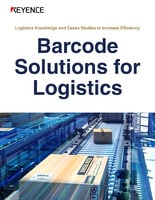Overview
Warehouses and delivery centers are important facilities that support logistics. Warehouses and delivery centers have various functions, and the most important of those functions are storage and cargo handling.
Storage is the function to store and manage products until they are shipped. Cargo handling is the function involved with receiving and shipping products. This also includes picking and sorting by destination. These functions are connected in warehouses and delivery centers to achieve a smooth flow of goods from producers to consumers and customers.
- Flow at Logistics Worksites
- People Are the Cause of Mistakes and Inefficiencies at Logistics Worksites
- Move from the Eyes of People to the Eyes of Machines for Higher Efficiency and to Eliminate Mistakes
- Greatly Change Worksites by Adopting Handheld Computers
Flow at Logistics Worksites
In order to deliver products from producers to consumers and customers without delay, the processes from receiving to shipping and the status of inventory must be strictly managed at warehouses and delivery centers. There are seven processes between receiving and shipping, and many of these rely on human labor and visual checks. As a result, simple mistakes happen and problems occur such as mistaken shipments and inventory discrepancies. To solve these problems at logistics worksites, it is first important to understand the flow in warehouses and delivery centers.
- Basic Flow from Receiving to Shipping

People Are the Cause of Mistakes and Inefficiencies at Logistics Worksites
Many of the problems at warehouses and logistics centers are inspection mistakes during receiving and shipping. Especially at conventional worksites that have not adopted devices, such as handheld computers, products are visually checked against receiving and shipping lists, so these worksites have problems in which oversights and omissions occur easily. The cause of these mistakes and inefficiencies lies in work that relies on human labor and visual checks.
Inventory management is very important at logistics worksites. If there is a flaw in the inspection work, a discrepancy will occur between the recorded inventory and the actual inventory, and waste will occur when moving products, such as by verifying products again or stopping work. And if there are mistaken shipments due to inspection mistakes, this can lose customer trust.
Move from the Eyes of People to the Eyes of Machines for Higher Efficiency and to Eliminate Mistakes
As mentioned above, the cause of mistakes that occur at logistics worksites is people. Mistaking products A and B because they look similar or missing one digit of a long product number are typical examples of human error due to false recognition by the brain. These kinds of mistakes and problems cannot be eliminated as long as inspections rely on visual checks. Mechanizing the confirmation work that relies on visual checks is important. And handheld computers are used as the eyes of machines.
Greatly Change Worksites by Adopting Handheld Computers
The cognitive functions of humans, such as visual checks and memory, have limits. Machines can accurately execute tasks that are difficult for humans, such as remembering things, identifying small differences, and identifying and recording only the desired item out of a large volume of information. If handheld computers are adopted for inventory management overall in the logistics processes and not just in receiving inspections, many of these human errors that have been problems up to now can be eliminated.
This section describes the logistics improvement case studies separated into the following parts: receiving inspections, allocation, picking, shipping inspections, taking inventory, and automation in warehouses and delivery centers. These case studies solve various issues and problems by using handheld computers. Also provided are additional sections that cover logistics improvement case studies at manufacturing factories and in transportation. Be sure to read these case studies if you are concerned about higher efficiency and making improvements at logistics worksites.
- For Warehouses and Delivery Centers
- For Manufacturing Factories
- For Transportation





